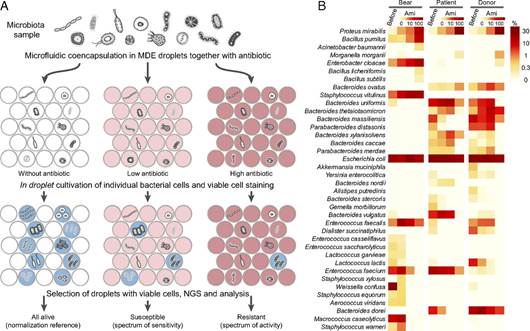


近日,一项刊登在国际杂志PNAS上的研究报告中,来自俄罗斯和美国的研究人员通过联合研究发现,西伯利亚棕熊的唾液中含有的特殊化学物质能够有效杀灭金黄色葡萄球菌。
文章中,研究人员对棕熊亚种机体的微生物组进行了深入研究;西伯利亚棕熊生活在蒙古国、中国北部和西伯利亚,虽然它们大多数吃的是素食,但有时也会捕杀驯鹿、麋鹿和鱼类作为食物,因此对西伯利亚棕熊机体的微生物组进行研究具有极其重要的意义。研究人员对棕熊机体生物谱系的研究是他们进行大规模野生动物生物群落研究的一部分,他们最终的目标是寻找能帮助杀灭感染人类机体致病菌的天然化合物,由于抗生素的滥用及细菌的进化,如今细菌耐药性的出现成为了全球公共卫生所面临的一大挑战,因此本文研究结果对于研究人员开发杀灭耐药性致病菌的新型疗法非常重要。
为了研究西伯利亚棕熊机体的微生物组,研究人员从棕熊生活地区的针叶树林地带采集了相应的标本进行研究,随后将棕熊的唾液样本带回实验室进行研究,在实验室中,研究人员利用先进的筛选技术鉴定了棕熊唾液样本中所含有的特殊化合物和有机物。研究者表示,棕熊唾液中存在一种名为短小芽胞杆菌的细菌,其能够产生名为amicoumacin A的抗生素化合物,当棕熊摄入特殊类型的植物时就会获得这些细菌。
随后研究者就想知道,唾液中短小芽胞杆菌所分泌的抗生素amicoumacin A是否能对其它感染性病原体产生影响,于是他们就测试了这种特殊抗生素对金黄色葡萄球菌的作用效果,结果表明,抗生素amicoumacin A能够有效杀灭金黄色葡萄球菌,这种天然抗生素在帮助人类机体抵御金黄色葡萄球菌引发的感染上具有重要的价值。
下一步研究人员将会继续深入研究棕熊及其它野生动物机体的生物群落,他们希望能够寻找到更多方法(比如棕熊唾液中的天然化合物)来帮助解决耐药性细菌感染等更多人类疾病。(来源:生物谷Bioon.com)
Ultrahigh-throughput functional profiling of microbiota communities
Abstract Microbiome spectra serve as critical clues to elucidate the evolutionary biology pathways, potential pathologies, and even behavioral patterns of the host organisms. Furthermore, exotic sources of microbiota represent an unexplored niche to discover microbial secondary metabolites. However, establishing the bacterial functionality is complicated by an intricate web of interactions inside the microbiome. Here we apply an ultrahigh-throughput (uHT) microfluidic droplet platform for activity profiling of the entire oral microbial community of the Siberian bear to isolate Bacillus strains demonstrating antimicrobial activity against Staphylococcus aureus. Genome mining allowed us to identify antibiotic amicoumacin A (Ami) as responsible for inhibiting the growth of S. aureus. Proteomics and metabolomics revealed a unique mechanism of Bacillus self-resistance to Ami, based on a subtle equilibrium of its deactivation and activation by kinase AmiN and phosphatase AmiO, respectively. We developed uHT quantitative single-cell analysis to estimate antibiotic efficacy toward different microbiomes and used it to determine the activity spectra of Ami toward human and Siberian bear microbiota. Thus, uHT microfluidic droplet platform activity profiling is a powerful tool for discovering antibiotics and quantifying external influences on a microbiome.
原文链接:http://www.pnas.org/content/pnas/early/2018/08/29/1811250115.full.pdf



